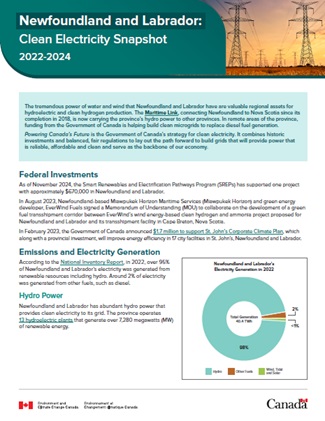Newfoundland and Labrador: Clean electricity snapshot
2022-2024
The tremendous power of water and wind that Newfoundland and Labrador have are valuable regional assets for hydroelectric and clean hydrogen production. The Maritime Link, connecting Newfoundland and Labrador to Nova Scotia since its completion in 2018, is now carrying the province's hydro power to other provinces. In remote areas of the province, funding from the Government of Canada is helping build clean microgrids to replace diesel fuel generation.
Powering Canada's Future is the Government of Canada's strategy for clean electricity. It combines historic investments and balanced, fair regulations to lay out the path forward to build grids that will provide power that is reliable, affordable and clean and serve as the backbone of our economy.

Download the alternative format
(PDF format, 479 KB, 2 pages)
Federal investments
As of November 2024, the Smart Renewables and Electrification Pathways Program (SREPs) has supported 1 project with approximately $670,000 in Newfoundland and Labrador.
In August 2023, Newfoundland-based Miawpukek Horizon Maritime Services (Miawpukek Horizon) and green energy developer, EverWind Fuels signed a Memorandum of Understanding (MOU) to collaborate on the development of a green fuel transshipment corridor between EverWind's wind energy-based clean hydrogen and ammonia project proposed for Newfoundland and Labrador and its transshipment facility in Cape Breton, Nova Scotia.
In February 2023, the Government of Canada announced $1.7 million to support St. John's Corporate Climate Plan, which along with a provincial investment, will improve energy efficiency in 17 city facilities in St. John's, Newfoundland and Labrador.
Emissions and electricity generation
According to the National Inventory Report, in 2022, over 98% of Newfoundland and Labrador's electricity was generated from renewable resources including hydro. Around 2% of electricity was generated from other fuels, such as diesel.

Long description
| Electricity source | Quantity |
|---|---|
| Coal | 0.00% |
| Natural gas | 0.00% |
| Other fuels | 2.00% |
| Nuclear | 0.00% |
| Hydro | 98.00% |
| Other renewables | <1% |
| Total TWh | 40.4 |
Note: Totals may not add up due to rounding
*Renewables: Includes electricity generation by wind, tidal and solar.
*Other fuels: Includes GHG emissions from the combustion of refined petroleum products (light fuel oil, heavy fuel oil, and diesel), petroleum coke, still gas and other fuels not easily categorized.
Source: National Inventory Report 1990-2022: Greenhouse Gas Sources and Sinks in Canada, Part 3, Annex 13.
Hydro power
Newfoundland and Labrador has abundant hydro power that provides clean electricity to its grid. The province operates 13 hydroelectric plants that generate over 7,280 megawatts (MW) of renewable energy.
In December 2024, Newfoundland and Labrador signed an historic MOU with Quebec to terminate and replace the 1969 Upper Churchill Contract, develop Gull Island and expand and modernize the capacity of the Churchill Falls plant. This deal will result in more than $225 billion in total revenue to the provincial treasury over the life of the agreement. The new developments will increase the province’s capacity by 3,900 MW.
The Churchill Falls Hydroelectric Generation station is the largest hydroelectric plant in the province. With the MOU in place, the province will build a new powerhouse which will add 1,100 MW. The existing units at Churchill Falls will be ungraded to increase capacity by 550 MW. It has a capacity to generate 5,428 MW of electricity and generates over 34 terawatt hours (TWh) of energy annually.
Hydrogen
A 2023 partnership between Newfoundland and Labrador and Port of Rotterdam will encourage export of clean hydrogen from Newfoundland and Labrador to the Netherlands.
The Government of Newfoundland and Labrador has issued Recommendation Letters allowing four companies to pursue development of wind-hydrogen facilities on Crown land. This will create jobs and economic opportunities for the province.
Wind power
In March 2023 the Government of Canada and province of Newfoundland and Labrador began an 18-month regional assessment of offshore wind off the coast of Newfoundland and Labrador. The final regional assessment report is expected to be published in January 2025.
In October 2024, Bill C-49, the Accord Acts Amendments Act, received Royal Assent. The Government of Newfoundland and Labrador is advancing a mirror version of the legislation. The Accord Act amendments will spur investment and drive job creation by providing the legislative framework for the joint management of offshore renewable energy development off the coast of Newfoundland and Labrador. This will position the province to develop its strong offshore wind resources and provide an economic boost to its clean energy and marine services industries.
Economic opportunities
In addition to cleaner air and lower greenhouse gas emissions, a clean electricity grid can stimulate investment in innovation, provide economic opportunities, and create good jobs.
New jobs
Electrification and the transition to cleaner forms of electricity generation is expected to create good jobs across Canada. For instance, independent experts from Clean Energy Canada (PDF) forecast that the Atlantic provinces will see thousands of clean energy jobs added in the Atlantic region between 2025 and 2050.
A proposed wind-to-ammonia project in Newfoundland and Labrador would create 2000 construction jobs and 500 permanent jobs. The project would transform wind power to ammonia to be shipped around the world.